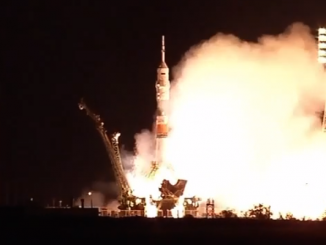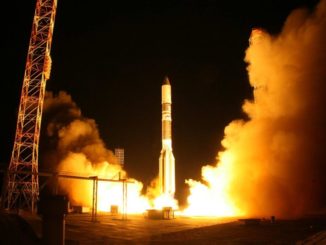
Russian technicians have finished tests of launch facilities at the Vostochny Cosmodrome ahead of the first liftoff from the new Siberian spaceport as soon as next month, Roscosmos announced Friday.
The product of a multibillion-dollar investment by the Russian government, the new launch base is located in Russia’s Amur region near the Chinese border about 3,400 miles (5,500 kilometers) east of Moscow. It will eventually host most of the launches currently taking off from the Baikonur Cosmodrome in Kazakhstan as Russia aims to base more of its space missions from its own territory.
Ground crews rolled out the Soyuz-2.1a rocket assigned for the first flight from Vostochny to its launch pad at dawn March 21.
The rollout from a nearby assembly building marked the start of a week of ground tests and functional checks between the Soyuz rocket, its Volga upper stage and the newly-constructed launch pad.
A hydraulic lift erected the Soyuz booster vertical atop its launch mount, then the facility’s mobile service gantry wheeled into position around the rocket for electrical testing.
On March 22, another round of comprehensive checks focused on the electromagnetic compatibility between the rocket and Vostochny’s ground systems. Ground teams transferred the launch pad’s mobile service tower to its launch position to allow the cosmodrome’s communications station to receive telemetry from the rocket. The day’s tests concluded with the retraction of the launch pad’s fueling and umbilical masts to demonstrate their function, according to Roscosmos.

The images posted here were released by TsSKB Progress, the manufacturer of the Soyuz rocket based in Samara, Russia.
The Soyuz launch team simulated loading kerosene and liquid oxygen propellants into the three-stage rocket March 23, Roscosmos reported in a press release. The next day, engineers rehearsed launch abort procedures at Vostochny.
The rocket returned to its integration building Friday for final prelaunch checks and the attachment of its three satellite payloads.
The satellites include the 1,170-pound (531-kilogram) Aist 2D spacecraft, made by TsSKB Progress in partnership with Samara State Aerospace University, which will demonstrate a new small spacecraft design with a high-resolution hyperspectral imaging camera. Aist 2D also carries an innovative radar operating in P-band, a wavelength that penetrates through forest canopies and Earth’s surface to study underground structures.

Another spacecraft aboard the first launch from Vostochny comes from students at Lomonosov Moscow State University. Named for Mikhailo Lomonosov, an 18th century Russian scientist and writer, the spacecraft will weigh nearly 1,000 pounds (about 450 kilograms) at liftoff, according to the mission’s website.
The Mikhailo Lomonosov satellite will study high-energy cosmic rays and gamma-ray bursts, the most powerful explosions in the universe astronomers believe come from the collapse of massive stars at the end of their lives.
Other sensors on the spacecraft will look at Earth’s magnetosphere, the bubble that protects the planet from harmful solar and cosmic radiation.
A tiny student-built CubeSat the size of a shoebox will also launch on the Soyuz-2.1a rocket.
The launch date has not been confirmed, but several reports point to a preliminary target date around April 25.
Email the author.
Follow Stephen Clark on Twitter: @StephenClark1.



